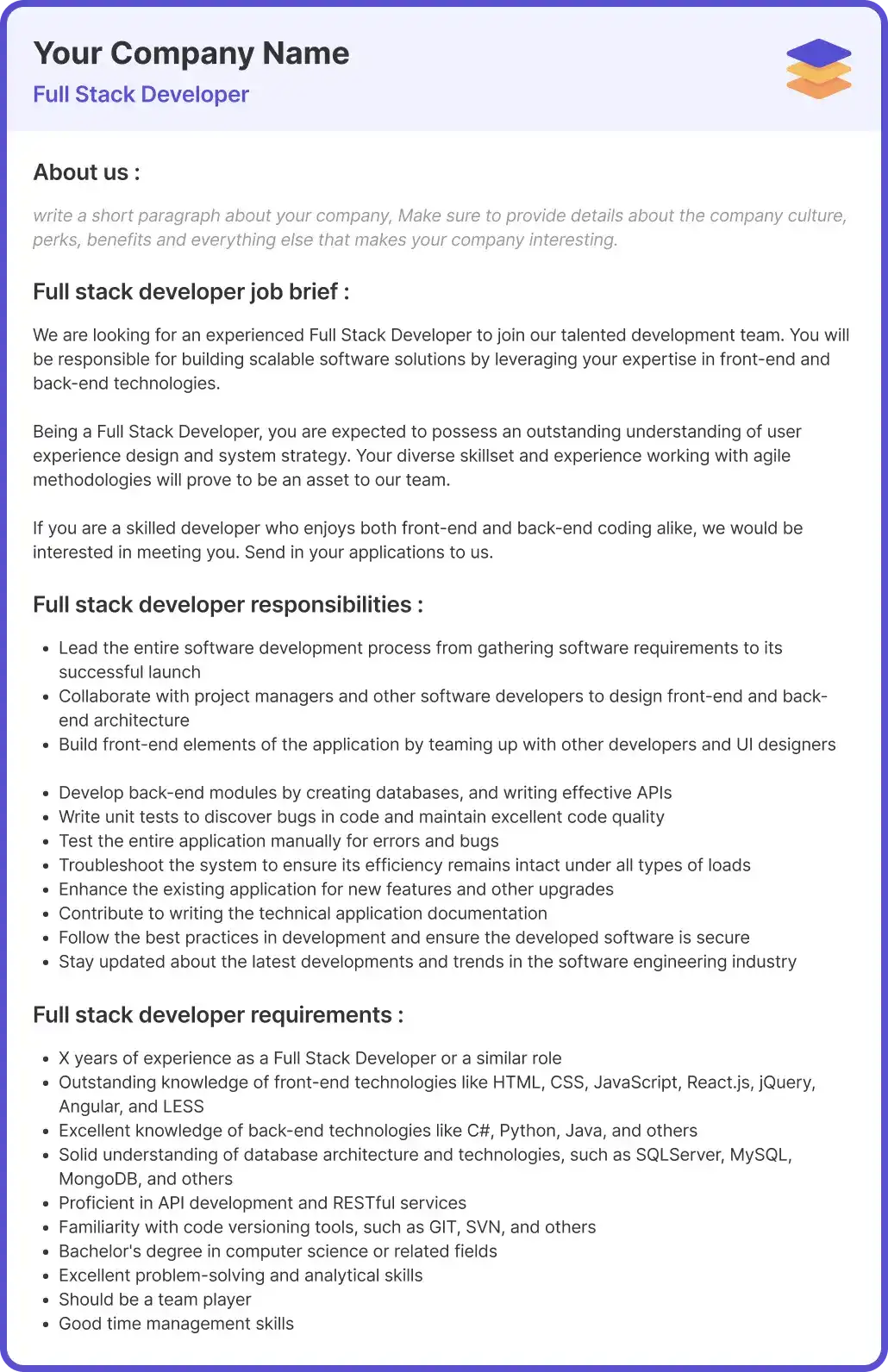Full-Stack Development
What is Full-Stack?
 A typical illustration for full-stack engineering shows layers of an application: the front end (HTML/CSS/JS, UI frameworks like React/Angular), the back end (server code in Node.js, Java, or Python), and the database (e.g., SQL, MongoDB), with arrows showing how a full-stack engineer navigates and builds each.
A typical illustration for full-stack engineering shows layers of an application: the front end (HTML/CSS/JS, UI frameworks like React/Angular), the back end (server code in Node.js, Java, or Python), and the database (e.g., SQL, MongoDB), with arrows showing how a full-stack engineer navigates and builds each.Core Responsibilities of a Full-Stack Engineer
- Back-End Development: Creating, maintaining, and optimizing application logic, APIs, server-side processes, and integrating databases using languages like Python, Java, Node.js; frameworks like Django or Express; and SQL/NoSQL databases. [e747nb]
 A practical example: A company building a SaaS dashboard might hire a full-stack engineer to design the dashboard's UI, connect it to cloud services via APIs, build the data storage layer, and deploy the application—all handled by the same individual or small team.
A practical example: A company building a SaaS dashboard might hire a full-stack engineer to design the dashboard's UI, connect it to cloud services via APIs, build the data storage layer, and deploy the application—all handled by the same individual or small team.When to Choose Full-Stack Engineers vs. Specialized Talent
| Situation | Full-Stack Engineer | Specialized Talent |
| Early-stage/startup | Resource-constrained, need agility—one person can prototype, launch, and iterate quickly. [8a428b] [wk11os] | May be excessive unless tackling deep technical challenges requiring domain mastery. |
| Small to mid-size projects | Provides flexibility and rapid iteration with fewer coordination hurdles. | Useful if project requires advanced, nuanced knowledge in specific domains. |
| Rapid prototyping/MVP | Ideal for speed—broad skills cover all requirements. | Specialists often slow down rapid initial build. [oc79o1] |
| Scaling/complex systems | May reveal limits in depth for performance, security, scalability issues. | Need specialists (e.g., security engineer, database architect) for robustness, optimal design. |
| Long-term, mission-critical apps | Generalists may start but hand-off to focused experts as system grows. | Teams of specialists for front- or back-end ensure highest quality and maintainability. |
- Specialized talent is preferred when the application grows in complexity, scale, or performance/security requirements become critical; specialists offer deep, field-specific knowledge for refined, robust solutions. [oc79o1]
 A diagram comparing team structures:
A diagram comparing team structures:- Team A (full-stack): 2-3 engineers handling UI, services, and infrastructure.
- Team B (specialized): Distinct front-end, back-end, DevOps, and data specialists, each focused on their part of the technology stack.
- Full-stack engineering means an engineer can handle both client-side and server-side software, enabling rapid and holistic product development.
- Companies benefit from full-stack engineers for flexibility, speed, and cost-effectiveness in early or less complex projects.
Citations
[8a428b] 2025, Oct 11. Full-Stack Developer Job Description [Updated for 2025] - Indeed. Published: 2025-07-16 | Updated: 2025-10-11
[ql00wn] 2025, Sep 30. Job Role: Senior Full Stack Engineer (SQL + Angular). Published: 2024-06-29 | Updated: 2025-09-30
[oc79o1] 2025, Oct 07. What Is a Full-Stack Engineer? - Forage. Published: 2023-02-07 | Updated: 2025-10-07
[e747nb] 2025, Oct 12. Responsibilities: Mid-level Fullstack Engineer - Remotely. Published: 2025-01-01 | Updated: 2025-10-12
[wk11os] 2025, Oct 08. Full Stack Engineer Job Description Template - Braintrust. Published: 2020-06-24 | Updated: 2025-10-08
[g8wznv] 2025, Oct 12. What Is a Full-Stack Engineer? Job Description - Coursera. Published: 2025-02-21 | Updated: 2025-10-12
[eo3mof] 2025, Sep 08. Full Stack Engineer Job Description - IES Career Center. Published: 2023-01-01 | Updated: 2025-09-08